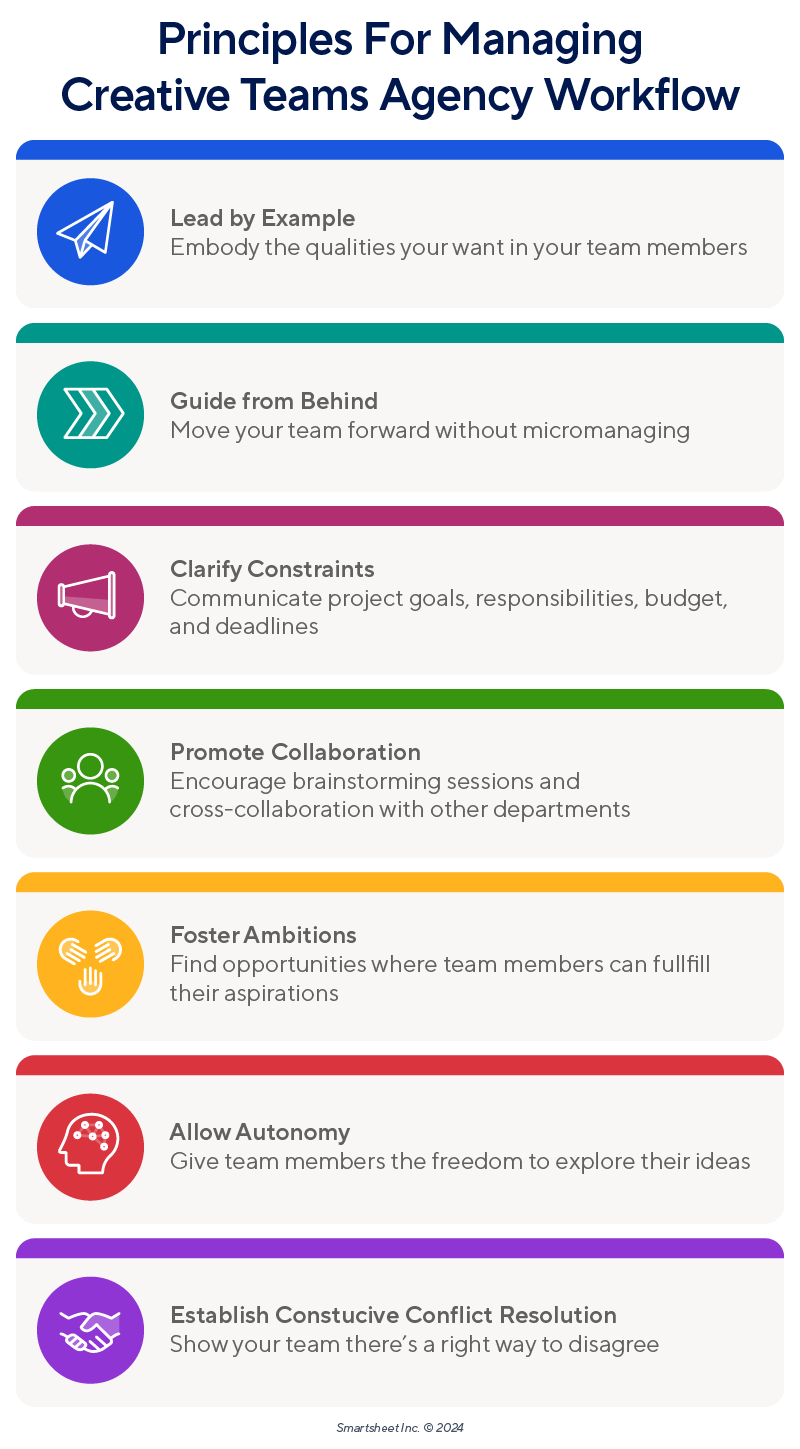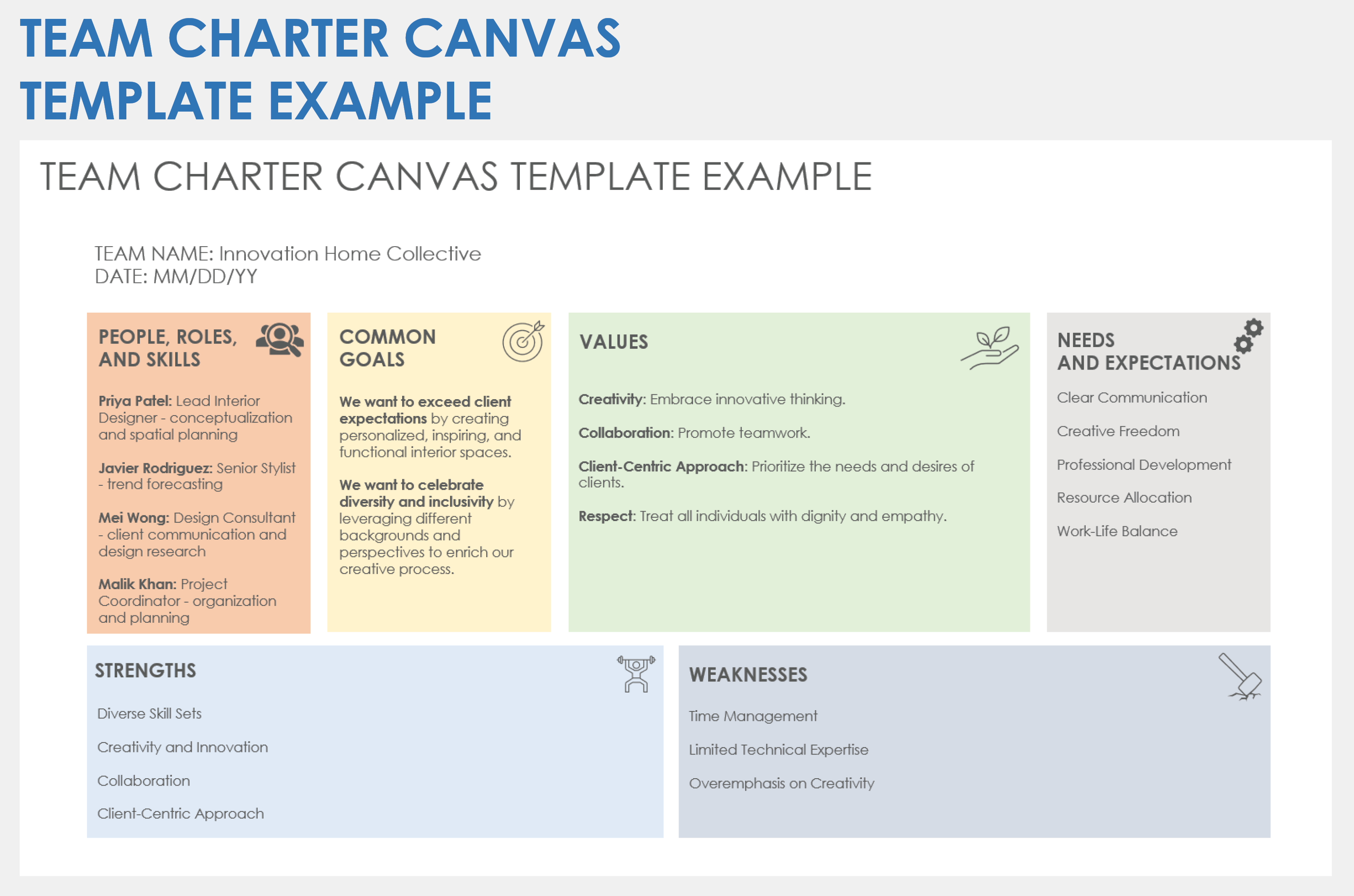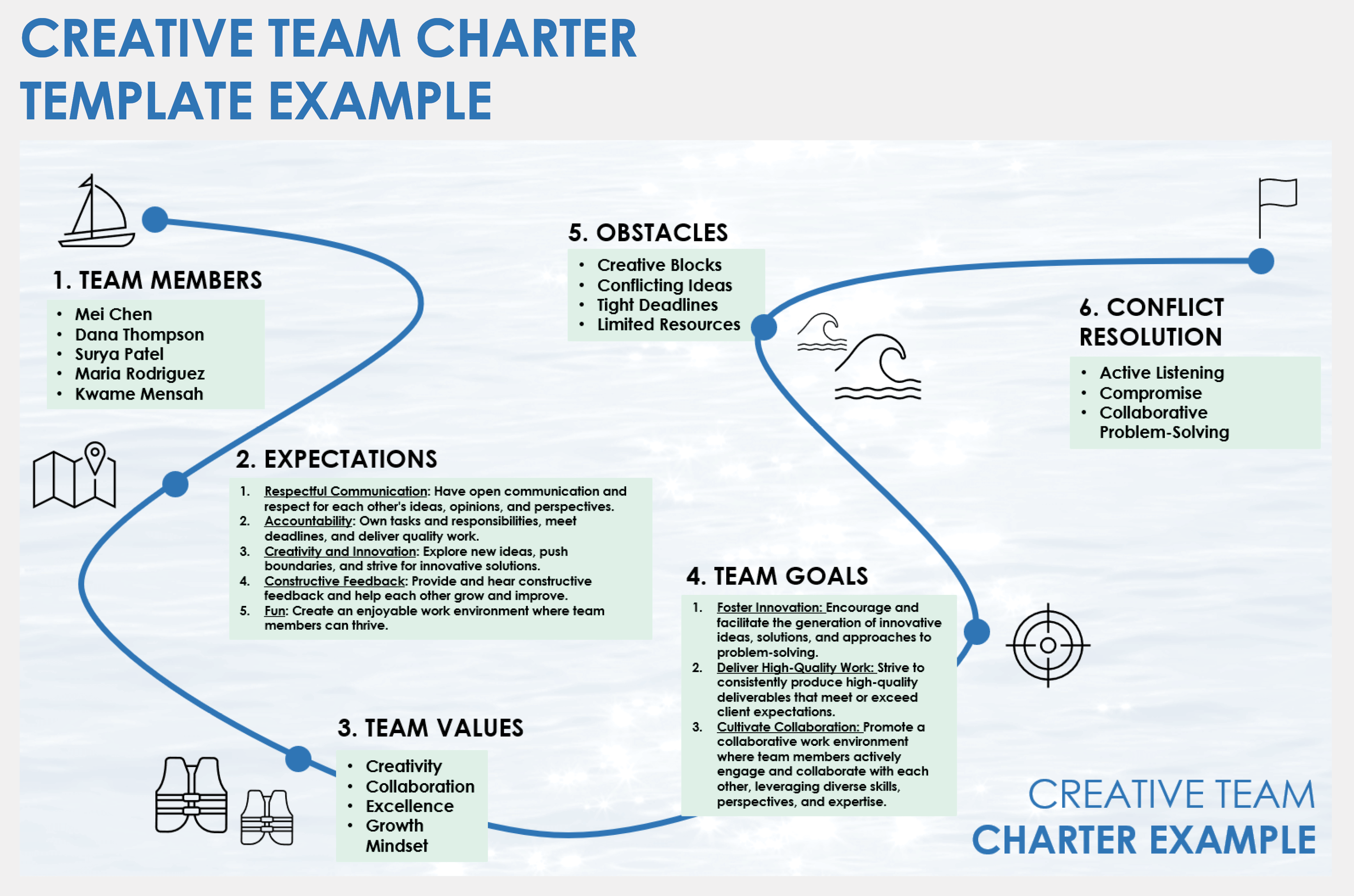Main Principles of Managing a Creative Team
Managing creative teams requires an unconventional style compared to managing finance, IT, customer service, or sales teams. Creatives encompass diverse personality types and perform best with a flexible management style. Follow these principles to manage a creative team effectively.

Lead by Example
Team members excel when they feel a sense of safety, support, and empowerment, fostered through effective communication and championing of their ideas. Earn trust and show support by going to bat for your team and their ideas.
Benjamin John is a creative director with more than a decade of experience honing his leadership abilities and effectively harnessing his team's creativity. He suggests, “Embodying the qualities you wish to see in your team sets a strong precedent. I train myself to do the job of the two levels above and two below me. If needed, I will work alongside the team. I am excited for the opportunity to teach a member a new skill and possibly learn one myself.”
- Guide From Behind
Move your team forward without micromanaging. Be available for guidance and suggestions, but do not assert authority or control. Your team needs to make mistakes so that they can learn from them.
A 2020 study from the Journal of Organizational Culture, Communications, and Conflicts titled, “Applying Project Management to Creative Industries: The Relationship Between Leadership Style and Project Success,” states, “With a growth creative mindset, making mistakes is viewed as an opportunity for learning, and learning from mistakes is essential for sustainable growth in creative abilities.” Clarify Constraints
Contrary to popular belief, creative teams actually perform better when there are clear constraints. When starting a new project, share briefs, and communicate the goals, responsibilities, budget, and deadlines. This approach helps team members focus on the project deliverables.
A 2022 article from the Department of Psychology at the University of Nebraska Omaha titled, “Leading Creative Teams: A Process-perspective with Implications for Organizational Leaders” advises, “Leaders who appropriately emphasize work parameters, requirements, timelines, and available internal/external resources better equip their creative teams to develop accurate cognitive representations of work problems.” The article also warns leaders to “be cautious of overdefining the work to ensure the application of creative solutions.”

Patrick Finch, an artist and Art Director at Aristocrat, has worked in the creative industry for more than 20 years. Finch shares, “I don’t have all the answers, and I may not have the proper direction for a project. You have to believe in your team and that they have creativity through delegation and setting clear expectations.”
- Promote Collaboration
Promote collaboration by encouraging brainstorming sessions, so the team can bounce ideas off each other. Welcome all ideas without judgment. There are no bad ideas in creative brainstorming.
John says, “Collaboration often leads to innovative solutions. Encouraging an environment where team members support and inspire each other is key. This can also be difficult to manage within a creative team due to egos and the common reclusiveness of many creatives. I have been burned by this in the past. If a team doesn't work well with each other, it can quickly shift from a healthy environment to a toxic one. It is up to the leader to establish clear boundaries and recognize when one is crossed.”
Try some of these brainstorming techniques with your creative team. - Foster Ambitions
Learn what your team members aspire to achieve in their roles and find opportunities where they can fulfill them. Perhaps it’s leading a project or moving into a senior role. Leverage their best skills so that they can develop what makes them great. Ensuring they understand the entire business also provides more growth opportunities. - Allow Autonomy
Creative teams thrive when they have the freedom to explore ideas and contribute to decisions.
John says autonomy is “absolutely crucial for fostering creativity and individual growth within the team. Giving team members the freedom to explore ideas is needed for inspired thought and creative problem-solving. In my opinion, autonomy only works if the team is not afraid to fail. As the creative leader, it is my duty to embody grace and empower exploration. Even Columbus got it wrong. He thought he was going to India but found something completely unexpected.” - Establish Constructive Conflict Resolution
Disagreement is inevitable in the creative space. Show your team there's a right and productive way to disagree. Discord often yields innovative ideas when communication remains respectful and team members actively listen and demonstrate empathy toward one another.
How Creative Team Management Differs From Other Business Roles
The nature of creative work and the diversity of creative personalities sets creative team management apart from managing other business teams. For example, a finance team manager anticipates precise outcomes grounded in data, whereas a creative team manager embraces the prospect of multiple solutions to a single challenge.
The table below compares the key differences between managing creative teams vs. other business teams.
Managing Creative Teams vs. Other Business Teams
Creative Teams | Other Business Teams |
|---|---|
Flexible | Structured |
Encourages collaboration & experimentation | Promotes data-driven results |
Allows autonomy & freedom | Closely oversees work |
Welcomes new approaches | Adheres to protocols |
Understands results are subjective | Focuses on producing clear-cut results |
Check out this comprehensive guide to creative operations management to learn about creative operations trends and how to build a creative operations baseline.
How to Manage Creative Teams
Managing creative teams requires a flexible approach, clear communication, and encouragement. Follow the steps below to manage a creative team.
- Focus on Creative Direction
Provide suggestions that inspire instead of those that control. Nurture an environment where team members can bring their individuality and humanity into projects.
A 2020 study by Yuan Y and van Knippenberg D. titled “From Member Creativity to Team Creativity? Team Information Elaboration as Moderator of the Additive and Disjunctive Models” suggests since it’s unrealistic for managers to choose every creative member of their team, a precondition for success is really knowing the team and having a sense of its creativity composition. Managers should “aim to develop team processes to be conducive to the creative benefits of the team composition.” - Define Expectations
Share each project’s vision and expectations, including the tasks, who is responsible for each, and the deadlines. Use a project management tool such as a template or a dashboard that your team can easily access, so everyone is on the same page, understands their responsibilities, and focuses on the same goals.
Learn how to build a winning creative project management strategy. - Communicate Effectively
Use the communication platform that works best for your team, whether it’s email, videoconferences, or meetings outside the office. Show interest by asking what drives them, their mindset, their challenges, and so on.
“I have one-on-ones where I give each employee (14) an hour a month where it is all about them. We can talk about work, we can talk about TV, we can talk about the weather — it’s up to them, it’s their time. Last month, we talked about what makes you happy outside of work and focus on balancing work and home life,” Finch shares. “I am a leader and I know we have a business to run, but these people are also my family. Work should be fun and not stressful. People need to know that asking for help is not a weakness.” - Build a Creative Environment
Keep in mind that not all creatives work best in the same environment. One team member might thrive in a communal space with whiteboards and music, whereas another might prefer a quiet, isolated workspace. Ask your team members what they prefer, and do your best to meet their needs.
Creative space is not only physical — it’s also mental. Allow time to focus on problem-solving. Maybe that means taking a walk outside or holding no meetings on Fridays. Experiment with new ideas to see which work best. - Offer Flexible Work Hours
Some creatives work better early in the morning, and some late at night. Allow team members to work when their creativity is at its peak. Prioritize high-quality deliverables, not the hours it takes to complete them. This approach will produce better results and demonstrate that you care about and trust their creative process. - Provide Valuable Resources
Teams require resources to produce their best work. Resources may include tools, technology, time, and budget. Understanding the project scope is crucial for identifying what’s needed. Regularly check in with your team to ensure they have the proper support and tools.
A 2021 study from The Journal of The European Academy of Management explores the role of distinct variables (one being resources) in managing and supporting collective creativity by examining two industries: fashion textile design and design consultancy.
“Overall, the results of this study are consistent with the view that awareness of available and unavailable resources helps a team to give tangible form to its creative ideas. Rather than providing a vague abundance of resources, adequate resources must be clearly designed and defined.” - Encourage Teamwork/Foster Relationships
Promote cross-collaboration with other departments and ask for their input. Build relationships by learning about their processes, constraints, workflows, and resources. More ideas lead to finding the one that works best. Even a “bad” idea can be worked into a great one when a team collaborates. - Recognize Accomplishments
Celebrating team members’ accomplishments enhances their satisfaction. Providing positive feedback helps a team feel valued and motivated.
John says, “Regular acknowledgment fosters a positive work culture and motivates team members. It is not easy to be a creative thinker. It is tough stepping out into the void. I get excited when someone takes a risk. I applaud the effort over the outcome.” - Promote Learning
Encourage growth by providing opportunities for team members to learn new skills. Offer workshops and master classes. When your team knows you support their growth, they feel more motivated and understood.
Challenges of Managing Creative Teams
Managing creative teams has its challenges, such as finding the right balance in and out of work and meeting deadlines. Managers will also need to learn how to overcome communication issues and maneuver their team through creative blocks.
Follow these tips for understanding and overcoming the challenges of managing creative teams.
- Balance in the Workspace
Protect your team from administrative duties that can pull them away from their creative responsibilities. According to a 2020 study from the Journal of Organizational Culture, Communications and Conflicts titled, “Applying Project Management to Creative Industries: The Relationship Between Leadership Style and Project Success,” “Management in the creative industries is challenging due to the complex relationship between administrative work, art, and technology, which have to be coordinated in the right balance to achieve business objectives and retain creative integrity.” - Balance Outside the Workspace
A poor work-life balance can lead to burnout, resulting in diminished creativity and decreased productivity. Set realistic goals for team members. Encourage rest and time away from work. When employees take leave, ensure they are uninterrupted by work commitments and give them the opportunity to catch up when they return. - Meeting Deadlines
Communicate deadlines clearly and delegate tasks, making sure each team member understands their responsibilities. Empower the team to take ownership of their solutions, and offer ongoing feedback to demonstrate your readiness to provide assistance when needed. Keep communication channels open so that team members who are struggling can get their roadblocks addressed in a timely manner. - Communication Roadblocks
Messages sent through email, Microsoft Teams, or Slack might not be clear and cause confusion about direction and expectations. Responses from team members in different time zones might be delayed. Plan meetings and virtual events that align with everyone’s schedules. - Managing Creative Differences
Creatives come from varying backgrounds, which influence unique ideas. But there isn’t room for every idea in a project. Be sure to embrace diversity while finding common ground. John recommends, “Balancing diverse perspectives within the team, and going back to my favorite phrase, shared understanding."
Supporting evidence of the importance of team diversity comes from Namgyoo Kenny Park, Wanjin Jang, Evan Leigh Thomas, and Joshua Smith’s 2020 study, “How to Organize Creative and Innovative Teams: Creative Self-Efficacy and Innovative Team Performance.” The study results demonstrated that “the education background diversity of team members is a critical factor. It had a positive impact on innovative performance, indicating that it may increase knowledge, perspective, and problem-solving skills in the context of teams.” - Motivate During Creative Blocks
Creative teams will always have moments where they are searching for inspiration. When that occurs, have your team try something new, such as working from a new location, or participate in a team-building exercise. Hire an external speaker to provide new perspectives and inspire motivation.
John suggests, “If inspiration is difficult to find, I try to allow my team to step away from a project. Inspiration often comes when focused on something else.”
Creative Team Charter
A creative team charter is a document that outlines a team’s purpose, goals, values, roles, responsibilities, and expectations. The document explains how a team will collaborate, make decisions, and resolve conflict. Develop a team charter for new teams, and update it whenever the team members change.
Use one of these creative team charter templates to build the foundation for a cohesive and productive team.
Team Charter Canvas Template
Download a Blank Team Charter Canvas Template in
Google Slides |
PowerPoint
Download a Sample Team Charter Canvas Template in
Use this team charter canvas template to establish shared goals and expectations of team behavior. Fill in the team’s strengths and weaknesses to help with assigning project tasks and to illustrate the team’s goals, values, needs, and expectations.
Creative Team Charter Template
Download a Blank Creative Team Charter Template in
Download a Sample Creative Team Charter Template in
Use this creative team charter to establish your team’s culture, including how to navigate obstacles. Print the template on a large canvas and include all team members in building its content. Use sticky notes and markers to fill in the information. Once it’s complete, keep it in an easily accessible place.
Learn more about team charters using the essential guide to creating an effective team charter.
How to Manage Remote Creative Teams
Managing remote creative teams has become more common over the past few years and involves its own set of challenges, such as building meaningful connections among team members and fostering a good work/life balance. Follow these tips for managing remote creative teams:
- Create Connection
Without face-to-face interactions, remote workers lack the opportunity to spontaneously discuss tasks with coworkers, share meals, or take breaks together. This element of remote work can lead to feelings of isolation and disconnection from peers.
As a manager, find ways to connect your team. Dedicate time in meetings for conversations that don’t revolve around work. Create Slack channels for areas of interest, such as pets, plants, recipes, and vacation pictures. Request participants to turn on cameras during some meetings. Schedule virtual events, such as happy hours, meditations, workshops, or team-building activities.
Finch adds, “Dealing with remote team members can be challenging. When the only time you see each is through Zoom, there is a disconnect and a feeling of separation. I tend to communicate more with my remote employees just to maintain a connection. They need to know that they are included. We also try to have them join us in person for celebrations and informal parties to have those personal interactions of fun and laughs.” - Be Flexible
Workspaces for remote workers vary from coffee shops to sharing space with a spouse or roommate. They might have to balance caring for pets or children at home. Show empathy for their situation by providing flexible working hours, which can help decrease stress and lets them focus on work when needed. - Communicate Effectively
Communicating with people remotely means fewer nonverbal cues through instant messaging and email. Use the communication methods and platforms your individual team members prefer, whether it’s video calls, phone calls, emails, or instant messages. Dedicate Slack channels or Microsoft Teams chat groups to specific projects so the team can ask questions and provide feedback. Be clear when giving directions and setting expectations and ensure team members understand them despite the lack of face-to-face interactions.
According to a 2006 article titled, “Managing Creative Team Performance in Virtual Environments: An Empirical Study in 44 R&D Teams,” by Jan Kratzer, Roger Leenders, and Jo vanEngelen, “Creative work requires ad hoc communication in which the need to communicate often arises in an unplanned fashion. This implies that, when computer-driven communication is used for the performance of creative tasks, technologies are necessary that encourage more spontaneous interactions. This includes face-to-face meetings, email, and, to some extent, desktop videoconferencing and situations that permit the use of mixes of face-to-face and electronically mediated communication. Teams that use periodic face-to-face encounters or information technologies that simulate face-to-face contact, or both, are more likely to be creative as a team.” - Promote Work-Life Balance
Remote team members may struggle to maintain work-life balance, which can blur the boundaries between professional responsibilities and personal time. The result is team members who work continuously without breaks or respond to emails during evenings and weekends.
Set work-from-home guidelines such as dedicated working hours. Encourage team members to take regular breaks and time off. Regularly review workloads and check on your team to make sure they are not on the edge of burnout but also feel challenged and motivated. - Set Clear Expectations
Make sure remote team members know what you expect of them, including agreed upon work schedules and clearly communicated targets. Schedule regular meetings and performance reviews to maintain open communication and verify they are meeting goals. - Provide Tools
Set up your remote team for success with the tools (high-speed internet, multiple monitors, a headset, etc.) they need to complete their tasks. Use a project management tracking tool so the team can see who is responsible for what deliverables, timelines, any project changes, etc. - Build Standard Processes
Build standard processes (and automate any you can) to stay consistent and efficient. John says, “Make sure everyone knows the processes. I hold a standard for myself and my team to know the two job levels above and two job levels below my own. Things happen; people get sick, emergencies happen, or someone gets a new job. Everyone on the team needs to know what to do if a team member drops out.”
Read this guide about implementing and managing the creative workflow process to learn how to maintain a standardized process team members can follow.
Managers of Creative Teams Can Easily Meet Project Goals and Deadlines with Smartsheet
Empower your people to go above and beyond with a flexible platform designed to match the needs of your team — and adapt as those needs change. The Smartsheet platform makes it easy to plan, capture, manage, and report on work from anywhere, helping your team be more effective and get more done. Report on key metrics and get real-time visibility into work as it happens with roll-up reports, dashboards, and automated workflows built to keep your team connected and informed. When teams have clarity into the work getting done, there’s no telling how much more they can accomplish in the same amount of time. Try Smartsheet for free, today.

